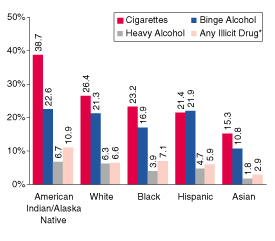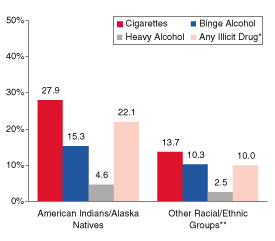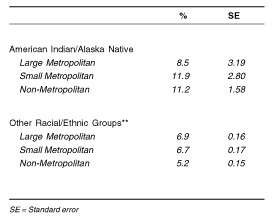
 |
| May 16, 2003 |
|
In Brief |
|
The National Household Survey on Drug Abuse (NHSDA) asks persons aged 12 or older about their use of cigarettes, alcohol, or an illicit drug during the past month. Binge alcohol use is defined as drinking five or more drinks on the same occasion (i.e., at the same time or within a couple of hours of each other) on at least 1 day in the past 30 days.1 Heavy alcohol use is defined as drinking five or more drinks on the same occasion on each of 5 or more days in the past 30 days; all heavy alcohol users are also binge alcohol users. Illicit drugs include marijuana/hashish, cocaine (including crack), inhalants, hallucinogens, heroin, or prescription–type drugs used nonmedically.
Respondents were also asked to report on their symptoms of abuse of or dependence on alcohol or illicit drugs. In the NHSDA, abuse and dependence are defined using criteria specified in the American Psychiatric Association's Diagnostic and Statistical Manual of Mental Disorders (DSM–IV), which includes such symptoms as physical danger, trouble with the law due to substance use, increased tolerance, and interference with everyday life during the past year.2
Responses were analyzed for comparative purposes by racial/ethnic subgroups and the type of county in which the respondents lived at the time of the interview.3 Except for data on dependence or abuse, all findings in this report are annual averages based on combined data from the 1999, 2000, and 2001 NHSDAs.
Figure 1. Percentages of Persons Aged 12 or Older Reporting Past Month Substance Use, by Race/Ethnicity: Annual Averages Based on 1999, 2000, and 2001 NHSDAs |
Figure 2. Percentages of Youths Aged 12 to 17 Reporting Substance Use, by Race/Ethnicity: Annual Averages Based on 1999, 2000, and 2001 NHSDAs |
 |
 |
Table 1. Percentages of Persons Aged 12 or Older Reporting Past Month Any Illicit Drug Use,* by Race/Ethnicity and County Type: 1999–2001 |
Figure 3. Percentages of Persons Aged 12 or Older Reporting Past Year Dependence on or Abuse of Any Illicit Drug* or Alcohol, by Race/Ethnicity: 2001 |
 |
 |
* "Any illicit drug" refers to marijuana/hashish, cocaine (including crack), inhalants, hallucinogens, heroin, or prescription–type drugs used nonmedically.
** Includes white, black, Hispanic, Asian, Native Hawaiian/other Pacific Islander, or more than one race.
Note: Binge alcohol use is defined as drinking five or more drinks on the same occasion (i.e., at the same time or within a couple of hours of each other) on at least 1 day in the past 30 days. Heavy alcohol use is defined as drinking five or more drinks on the same occasion on each of 5 or more days in the past 30 days; all heavy alcohol users are also binge alcohol users.
Source (Figures 1and 2, Table 1): SAMHSA 1999–2001 NHSDAs.
Source (Figure 4): SAMHSA 2001 NHSDA.
| The National Household Survey on Drug Abuse (NHSDA) is an annual survey sponsored by the Substance Abuse and Mental Health Services Administration (SAMHSA). The 1999, 2000, and 2001 data are based on information obtained from 207,470 persons aged 12 or older (about 70,000 each year), including more than 2,300 American Indians or Alaska Natives (about 775 each year). The survey collects data by administering questionnaires to a representative sample of the population through face–to–face interviews at their place of residence.
The NHSDA Report is prepared by the Office of Applied Studies (OAS), SAMHSA, and by RTI in Research Triangle Park, North Carolina. Information and data for this issue are based on the following publications and statistics: Office of Applied Studies. (2000). Summary of findings from the 1999 National Household Survey on Drug Abuse (DHHS Publication No. SMA 00–3466, NHSDA Series H–12). Rockville, MD: Substance Abuse and Mental Health Services Administration. Office of Applied Studies. (2001). Summary of findings from the 2000 National Household Survey on Drug Abuse (DHHS Publication No. SMA 01–3549, NHSDA Series H–13). Rockville, MD: Substance Abuse and Mental Health Services Administration. Office of Applied Studies. (2002). Results from the 2001 National Household Survey on Drug Abuse: Volume I. Summary of national findings (DHHS Publication No. SMA 02–3758, NHSDA Series H–17). Rockville, MD: Substance Abuse and Mental Health Services Administration. Also available on–line: http://www.oas.samhsa.gov. |
| The NHSDA Report is published periodically by the Office of Applied Studies, Substance Abuse and Mental Health Services Administration (SAMHSA). All material appearing in this report is in the public domain and may be reproduced or copied without permission from SAMHSA. Additional copies of this report or other reports from the Office of Applied Studies are available online: http://www.oas.samhsa.gov. Citation of the source is appreciated. |
|
This page was last updated on December 30, 2008. |